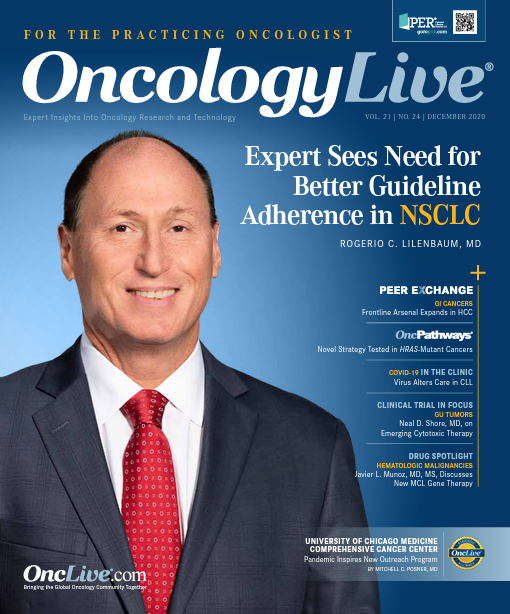Publication
Article
Oncology Live®
Markman: COVID-19 Takes Science on a Roller-Coaster Ride
Author(s):
In a pandemic, the public and its leaders yearn for relatively simple answers that can lead to solutions and forceful actions such as preventing serious infection and hospitalizations, treating active illness, and developing safe and effective vaccines quickly made available to the public.
Maurie Markman, MD

Finally, we have some good news about coronavirus disease 2019 (COVID-19), and it is very good news. Early reports suggest that at least 2 COVID-19 vaccines are both highly active, preventing approximately 95% of viral-associated illness including serious events, and are safe at least over the short term, measured by several months following vaccination. It is anticipated that vaccination of at-risk medical personnel and other first responders, as well as the most vulnerable populations, will begin before the end of the year or early in 2021, followed by widespread availability to the general public of several potentially very active and safe vaccines.1,2
Of course, this development and the impressive favorable early efficacy and toxicity results, are welcome. However, it is important to acknowledge there is nothing in the mandated process of rigorous, nonbiased, methodical, and careful external monitoring and review associated with the evaluation of these and other vaccine candidates that could have ensured these most favorable outcomes.
The scientific process itself, whether undertaken in the laboratory, the clinic, or in the even more complex sphere of public health, may be painfully slow to reveal data that can form the basis for meaningful and valid conclusions. In addition, initial and subsequent scientifically rational and encouraging hypotheses may lead to quite discouraging results when examined in the real world of human health and disease.
In a pandemic, the public and its leaders yearn for relatively simple answers that can lead to solutions and forceful actions such as preventing serious infection and hospitalizations, treating active illness, and developing safe and effective vaccines quickly made available to the public. Responses from the scientific community that are frequently and appropriately nuanced may not be well received. Further, the concept of changing recommendations, perhaps even resulting in contradictory suggestions based on evolving data, is difficult for many to understand and accept, particularly when such advice may have major economic and societal implications such as shutting businesses and closing schools.3,4
One can find no better examples than the issue of wearing masks in public or the need for social distancing to appreciate the confusion felt by the public.3 What is the evidence to support the public health value of these strategies and why have specific recommendation changed over the course of the pandemic?
It may not be terribly difficult for someone versed in the scientific method to appreciate the time required to obtain reliable data and the relevance of the various levels of evidence such as randomized trials, nonrandomized prospective observational studies, retrospective reviews of the electronic medical record, individual case reports, or population-based modeling efforts. However, most individuals and families faced with economic and personal hardships resulting from this pandemic will not feel comfort in these process issues.
So when the president of the United States rather forcefully declares that a well-established pharmaceutical agent (ie, hydroxychloroquine) offers major benefit in preventing serious complications of a COVID-19 infection and the clinical scientific community responds that this drug requires time-consuming detailed study in properly designed evidence-based randomized trials before it should be widely employed, it is not difficult to understand which voice may have the greater influence for many members of our society.5
Finally, it is relevant to acknowledge the unfortunate but measurable divide in this country for trust in science based on political affiliations.6 This is a most distressing situation because the basic goal of scientific research and clinical investigation is to improve our understanding of biology and human illness and to develop strategies to enhance the lives of all members of society. Individuals in the public health community devote their professional careers to applying the best available population science to help achieve these goals.
Something is terribly wrong if this simple yet profound idea has not been effectively communicated to the public. In the absence of such understanding and trust, is it any wonder that many refuse to listen to the extensive and highly relevant experience of members of the scientific and public health communities during a pandemic?
Of course, the severity of COVID-19 requires innovation in the exploration of the clinical utility and safety of novel strategies to treat and prevent this viral infection. The recent announcements regarding vaccine development are testimony to the successful efforts of many in the scientific, pharmaceutical, and governmental health communities.
One can hope that strategies designed to rapidly but rigorously explore new therapeutics can similarly be applied in the future to novel approaches in cancer management, including the exploration of the hundreds of molecularly based antineoplastic agents in pharmaceutical/biotech company pipelines that have the potential to meaningfully affect the quality and length of life for patients with malignant disease.
In the absence of such bold efforts to effectively examine the utility of these agents in as short a time as possible, how many lives of patients with cancer will be needlessly shortened?
References
1. Promising interim results from clinical trial of NIH-Moderna COVID-19 vaccine. National Institutes of Health. November 16, 2020. Accessed November 29, 2020. https://bit.ly/3qafD9o
2. Pfizer and BioNTech to submit emergency use authorization request today to the U.S. FDA for COVID-19 vaccine. News release. Pfizer and BioNTech. November 20, 2020. Accessed November 29, 2020. https://bit.ly/3mqfblg
3. Oreskes N. Scientists: use common sense. Sci Am. 2020;323(5):77. doi:10.1038/scientificamerican1120-77
4. Donohue JM, Miller E. COVID-19 and school closures. JAMA. 2020;324(9):845-847. doi:10.1001/jama.2020.13092
5. Saitz R, Schwitzer G. Communicating science in the time of a pandemic. JAMA. 2020;324(5):443-444. doi:10.1001/jama.2020.12535
6. U.S. leads in science trust gulf. Science. 2020;370(6512):15. doi:10.1126/science.abe9780



























%20(2)%201-Recovered-Recovered-Recovered-Recovered-Recovered-Recovered-Recovered-Recovered-Recovered-Recovered-Recovered-Recovered-Recovered-Recovered-Recovered-Recovered-Recovered.jpg?fit=crop&auto=format)
%20(2)%201-Recovered-Recovered-Recovered-Recovered-Recovered-Recovered-Recovered-Recovered-Recovered-Recovered-Recovered-Recovered-Recovered-Recovered-Recovered-Recovered-Recovered.jpg?fit=crop&auto=format)
